Have you seen your Ragdoll cat chase its tail and thought, “What’s going on in their head?” Cats, especially Ragdolls, have behaviors that both charm and puzzle us. They do things like chase their tails or show love through head-butting. These actions remind us of their wild and loving nature.
The slow blink is like a cat’s kiss, showing trust and love. Bringing you “gifts” is a sign of hunting skills and love. It might surprise you but head-butting means your Ragdoll is marking you with their scent. And finding your cat in the “cat loaf” position shows they feel safe and happy.
The way a cat’s tail twitches can tell us a lot about their feelings. Playful catnip adventures are just good fun. But what about tail chasing? This behavior shows the playful side of Ragdolls. Yet it might also signal something deeper, something important for their well-being that you should pay attention to.
Key Takeaways
- Ragdoll cats engage in a variety of peculiar behaviors, each with its own meaning.
- Understanding these behaviors can deepen the bond you have with your cat.
- Ragdoll cat tail chasing might be a playful instinct or something more significant.
- Tuning into the nuances of their actions can help in addressing any underlying issues.
- Common actions like kneading and slow blinking are signs of trust and love.
- The “cat loaf” position often indicates your cat feels safe and secure.
Introduction to Ragdoll Cats and Their Peculiar Behaviors
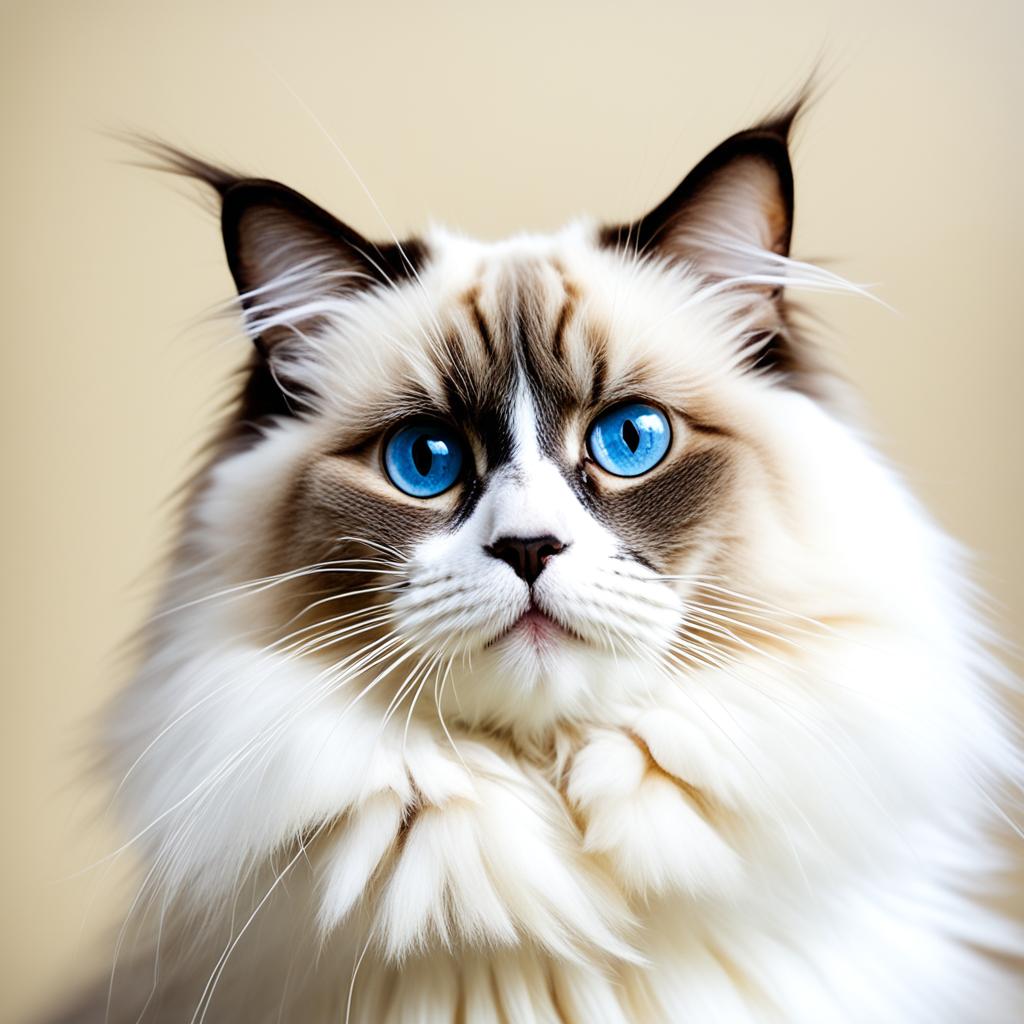
Ragdoll cats are loved for their mix of behaviors. They are playful, but not in the usual way. See, they love to chase their own tails. This might seem funny, but it’s a mix of natural and learned behaviors.
Understanding Ragdoll Cat Behavior
Ragdolls are known for being gentle yet playful. They love to chase their tails. Even though it looks silly, it’s a way for them to stay sharp and active.
The Charm of Ragdoll Cats
Ragdoll cats win hearts with their friendly nature and funny games. They enjoy playing in various ways, including tail chasing. This not only keeps them active but also brings them joy.
However, too much tail chasing could be a sign of stress. So, it’s good to pay attention to your cat’s behavior. This could help you find out if something is wrong.
Every Ragdoll is a bit different. They all have unique personalities. By understanding your cat, you can enjoy a stronger relationship. This also makes them healthier and happier.
Why Does My Ragdoll Cat Chase Its Tail?
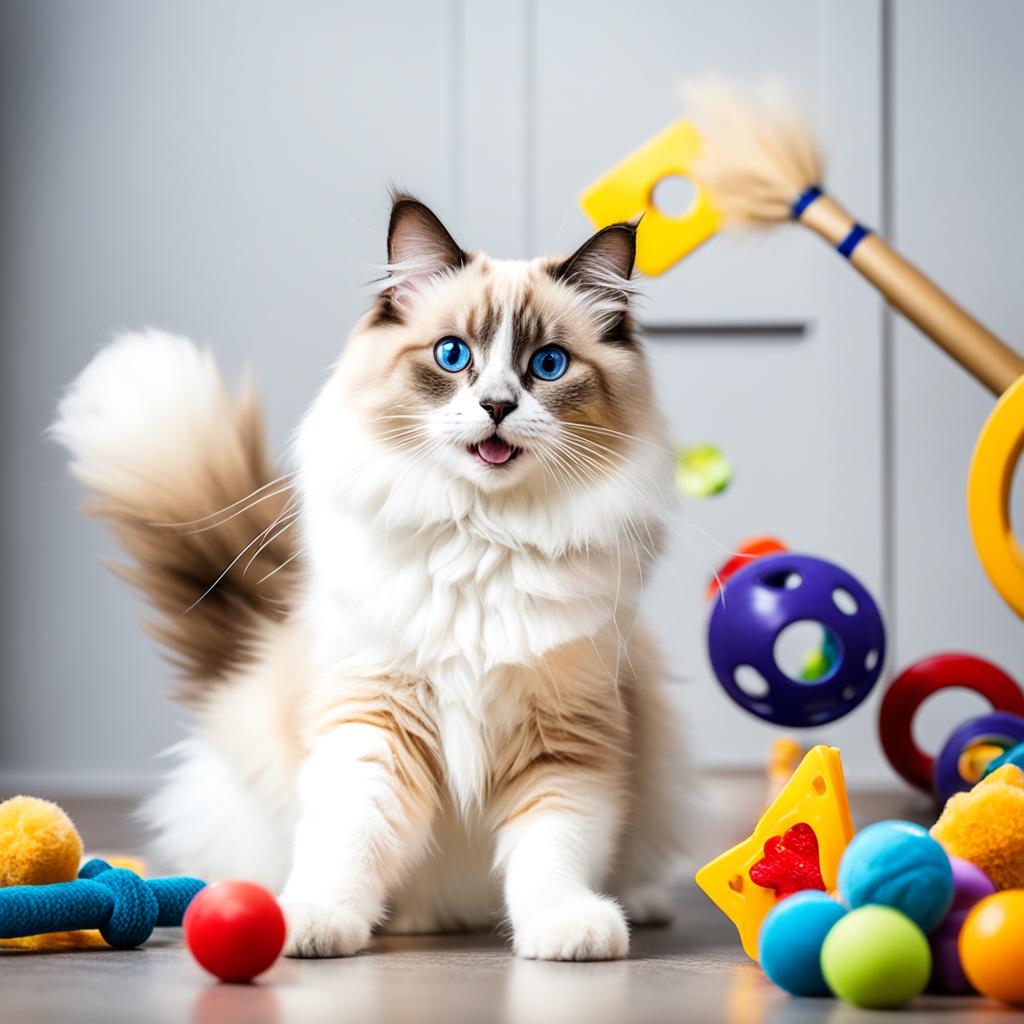
Have you ever wondered why your Ragdoll cat chases its tail? It’s interesting to look into why they do it. This habit can tell us more about our cats. It’s both funny and enlightening.
Playful Instincts
Ragdoll cats often chase their tails just for fun. It’s their way of playing and staying active. This is common behavior in homes with these lovely cats.
So, when your Ragdoll cat chases its tail, it might be playing to burn off energy.
Hunting and Predatory Behavior
Why Does My Ragdoll Cat Chase Its Tail? One reason is their hunting nature. Chasing their tail mimics the act of stalking and catching prey. Even though they are pets now, these instincts remain strong.
Thus, when your Ragdoll does this, it’s like they’re hunting something. It’s a glimpse into their wild side.
Possible Behavioral Issues
Sometimes, tail chasing can be a sign of something more serious. If a cat does it a lot, it might mean they are stressed or anxious. It could even signal a compulsive disorder.
It’s important to watch how often and when they chase their tail. This can help you understand if they need extra care. Maybe they just need extra playtime or attention.
Overall, keep an eye on your Ragdoll’s tail-chasing. If you’re worried, it’s okay to ask for help from a vet or a cat behaviorist. They are there to give you advice and support.
The Anatomy of a Cat’s Tail
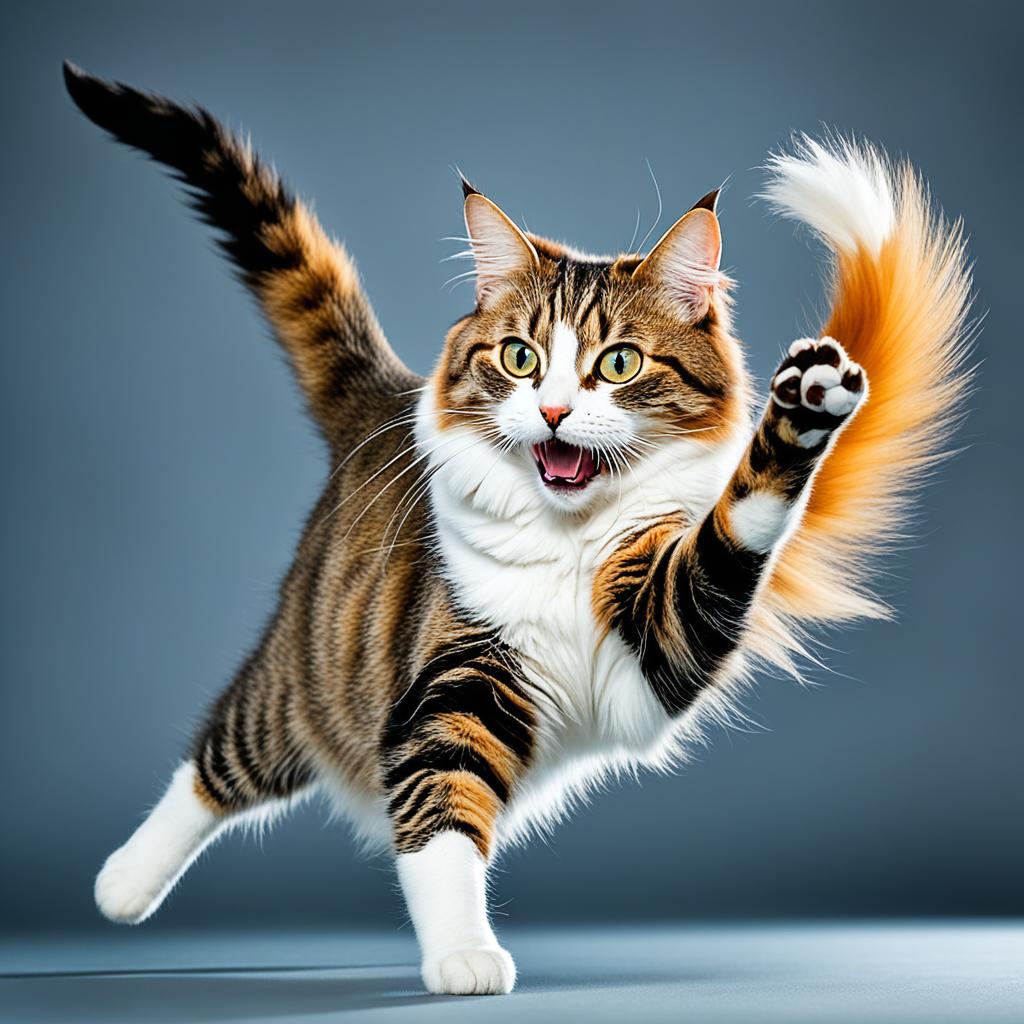
Cats have an amazing tail that’s key to lots of what they do. It’s not just for looks. Their tail helps them balance and show feelings.
Structure of a Cat’s Tail
A cat’s tail is built with small bones, muscles, and nerves. All these parts make a cat agile and balanced. The tail’s movement happens because of muscles. This lets cats do all their playful jumps and twists, like cat behavior tail chasing.
Role in Communication
A cat’s tail tells us a lot about how they feel. If a cat’s tail is up high, they’re probably happy. But if it’s tucked, they might be scared. It’s important to understand your cat’s tail language. This can help you care for them better. Even Ragdoll cat tail chasing shows they want to have fun or talk to you.
Sensory Capabilities
Did you know a cat’s tail can sense the world around them? It has special sensors for this. Sometimes, when a cat’s tail is being chased, it could be a sign of something bothering them. Keep an eye on Ragdoll cats’ tail movements. It might tell you what they feel, like stress or if they’re just having fun.
Common Reasons for Tail Chasing in Ragdoll Cats
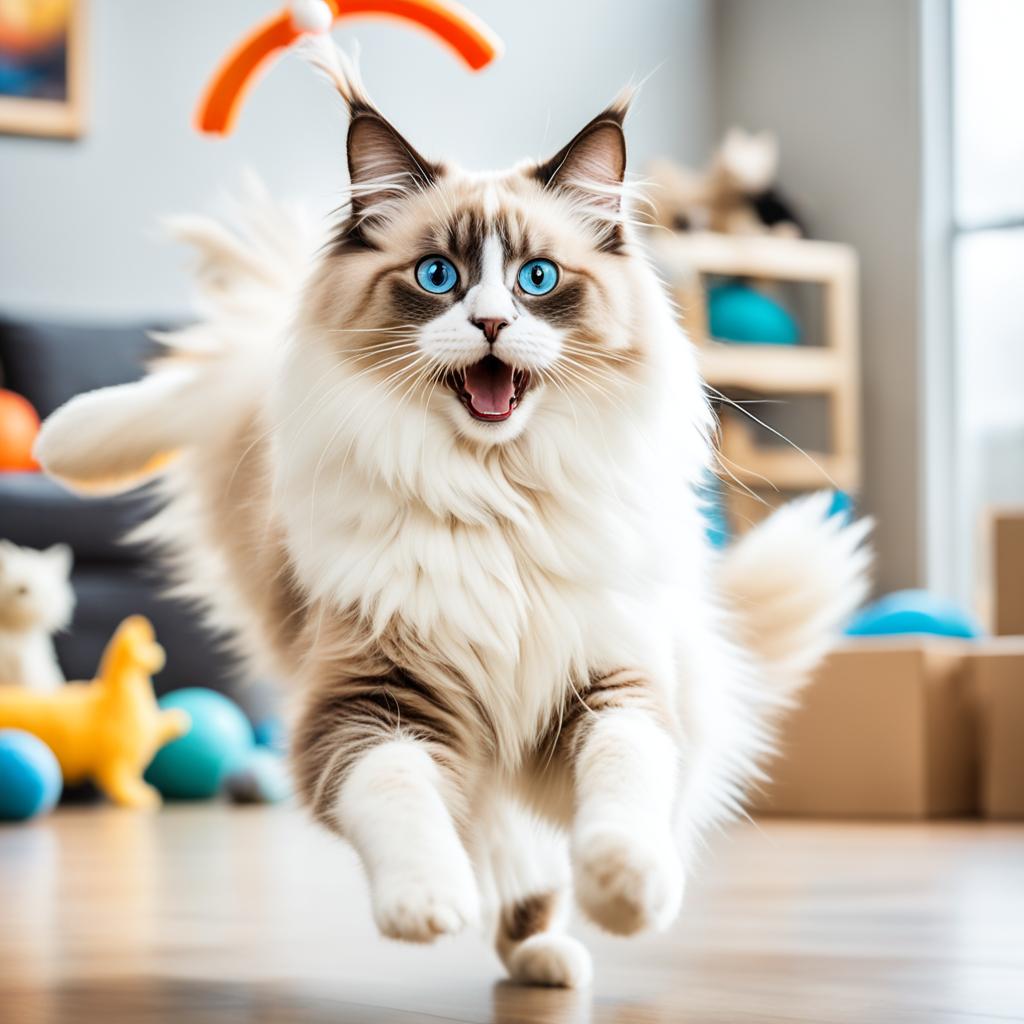
Seeing a Ragdoll cat chase its tail is both puzzling and fascinating. To figure out why it happens, we need to look at a few possible reasons. Some causes might surprise you.
Boredom and Lack of Stimulation
Boredom is a big Ragdoll cat tail chasing cause. If they don’t have enough to do, they might start chasing their tails. What can help? Interactive toys and playing with them regularly.
Health Issues and Discomfort
Ragdoll cat tail chasing can also signal a health problem. Things like skin allergies can irritate their tail and make them chase it. If they’re chasing their tail a lot, a vet visit is a smart move.
Injury or Medical Conditions
Injuries or illnesses are another piece of the puzzle. For instance, Feline Hyperesthesia Syndrome can make their tails extra sensitive. This calls for regular vet visits to catch and treat any issues in time.
Ragdoll Cat Play Behavior
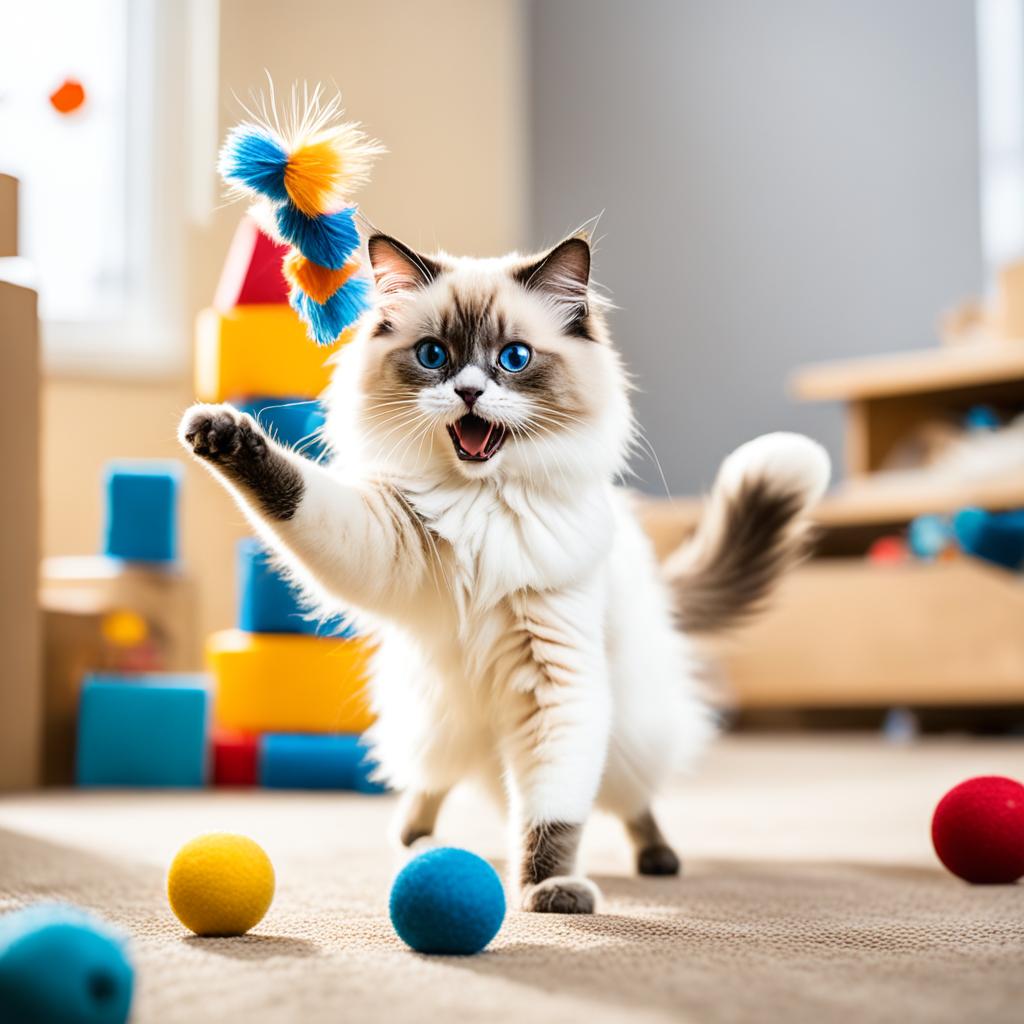
Ragdoll cats are gentle but also love to play. It’s important to know how they like to play to make sure they stay happy. Their playtime is their exercise and fun rolled into one.
Typical Play Activities
They enjoy chasing balls, leaping on toys, and pretending to hunt. These games are like their wild side coming out. It keeps them sharp and fit, just like in the wild.
Interactive Play with Owners
Playing games with their human is great for Ragdoll cats. You can play fetch or with toys like wands or lasers together. It’s not just fun; it deepens your bond and helps turn their wild energy into something positive.
Benefits of Active Play for Ragdolls
Playing with them is essential for their well-being. It helps them stay in shape and keeps them close to you. Regular play also lowers the chance they’ll do things like chase their tail. So, it’s more than just fun; it’s a way to help them be their best.
Differentiating Playful Tail Chasing from Problematic Behaviors
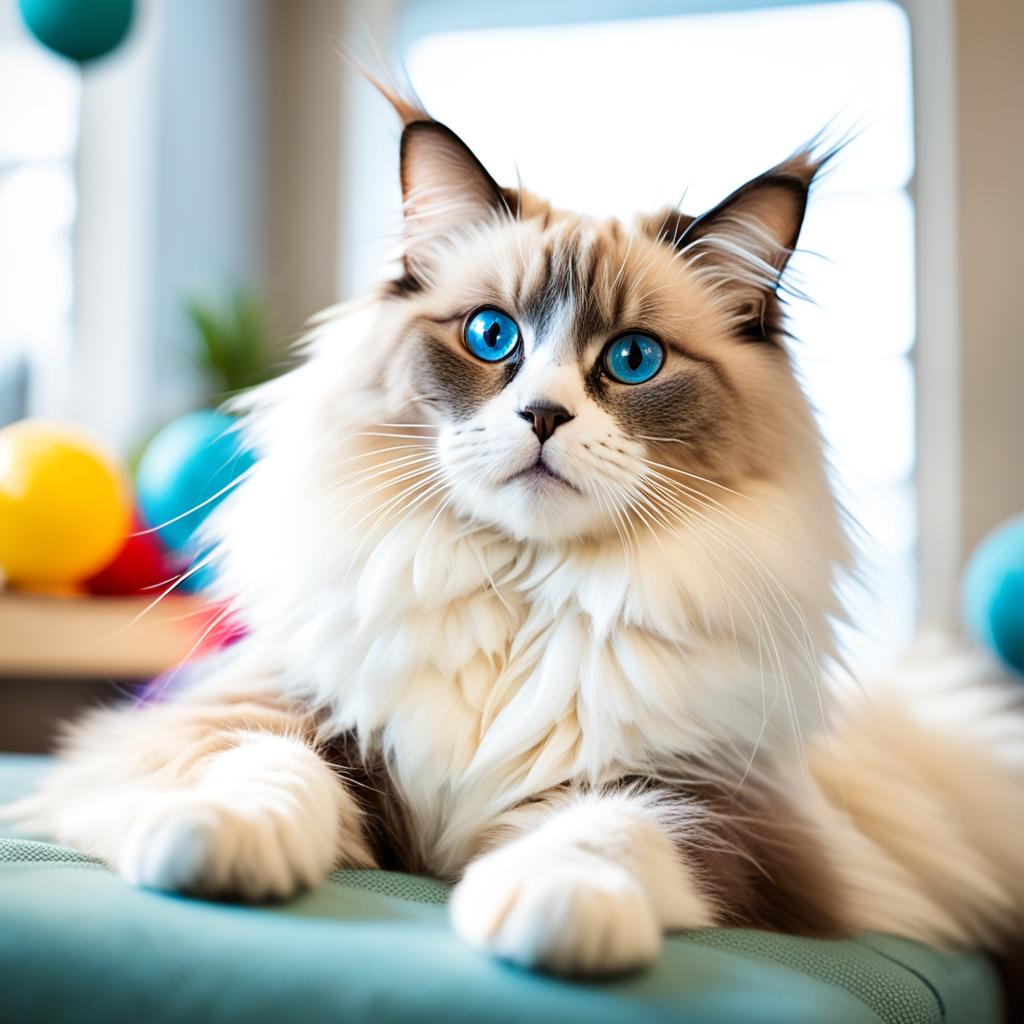
Trying to understand why your Ragdoll cat chases its tail is tricky. It’s hard to tell if it’s just having fun or if there’s a problem. We’ll look at some signs to help you figure this out.
Indicators of Normal Play
Normal tail chasing shows a few clear traits. The episodes are short, and your cat stays relaxed and happy. They also easily shift their focus to something else, like a toy or a snack. This is all part of normal tail chasing and games for Ragdoll cats.
Signs of Behavioral Problems
But, if tail chasing happens a lot or gets very intense, it might be a problem. Look out for other troubling signs, such as being too loud, acting out, or being anxious. When tail chasing stops being fun and becomes too important, it’s not normal anymore.
When to Seek Professional Help
If you are worried about your cat’s tail chasing, it might be time to see an expert. A vet or a cat behaviorist can check things out. They can see if there’s a health issue or a behavior problem. Getting expert help is the best way to keep your cat healthy and joyful.
Understanding Ragdoll Cat Tail Chasing
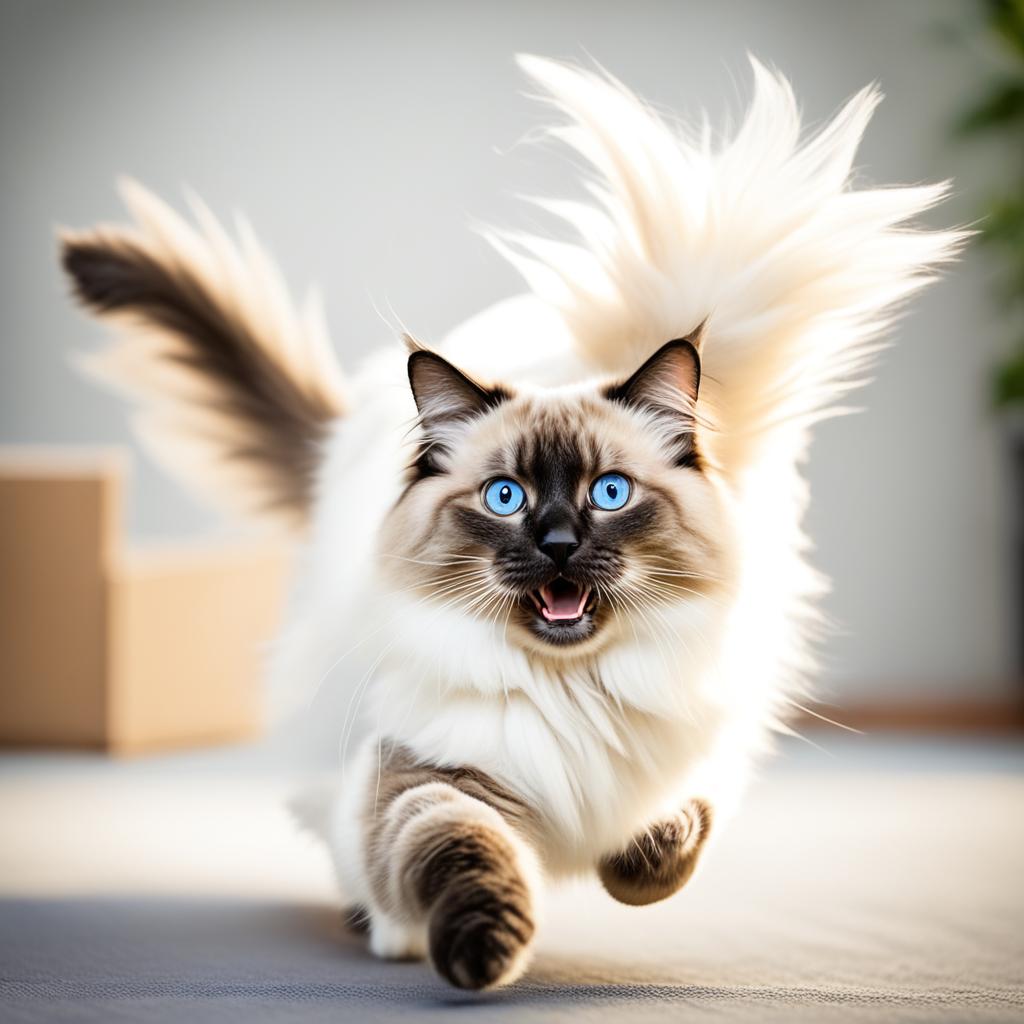
Ragdoll cats are known for their quirky habits, with tail chasing being a standout. But why do they chase their tails? Let’s explore the reasons for this amusing behavior.
Factors Influencing Tail Chasing
For Ragdoll cats, tail chasing is influenced by various factors. Some cats are just born to chase their tails. Younger cats, with their boundless energy, are more likely to do it. The environment, whether exciting or boring, also plays a big role.
Environmental and Psychological Triggers
Psychological triggers can lead Ragdoll cats to chase their tails. Stress, anxiety, and changes at home are key reasons. Things like a new pet or a sudden shift in routine can cause this behavior. As a cat owner, providing a calm and stable environment is crucial.
Playtime and engaging activities are vital. These can help your cat focus on something other than its tail. It’s also important to keep the home peaceful and well-stimulated. This will lower stress and prevent unwanted behaviors.
When you see your Ragdoll cat chasing its tail, think about these causes. Understanding why they do it can help you create a better, happier life for your cat.
Ragdoll Cat Tail Chasing Causes: From Play to Health Issues
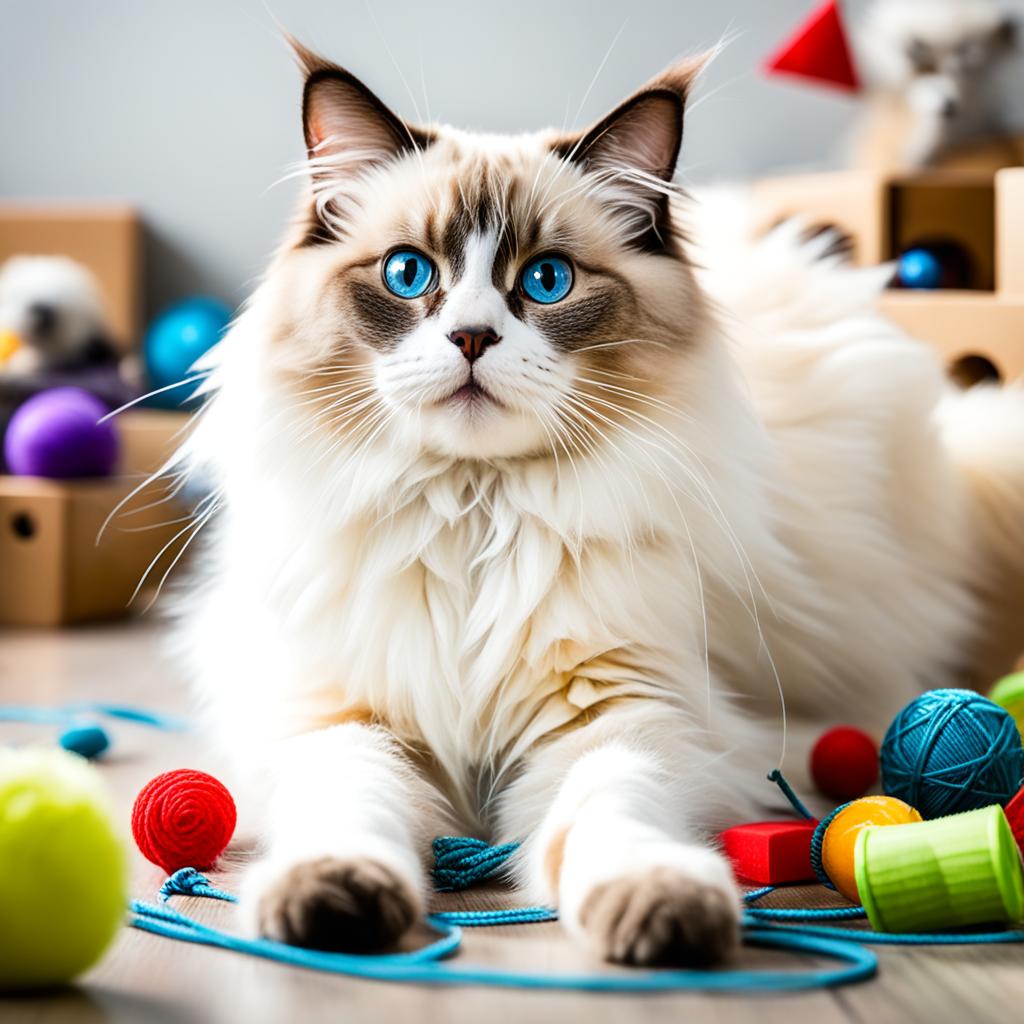
Ragdoll cats may chase their tails for various reasons. Some do it as fun, but others have deeper motives.
Playfulness often triggers tail chasing in these cats. They are naturally curious and love to be active. Chasing their tails can turn into a fun game. It might also be a sign they need more attention. This happens especially if they feel left out. If they’re stressed, they might do it to get noticed. It’s important to look for any changes or sources of stress around them.
Physical Health Concerns
Chasing their tails can also signal health issues. Allergies or irritations may be making them uncomfortable. They chase their tails to ease the itch. Infections or injuries near the tail area are serious too. Regular vet visits can help find and treat these problems early. This keeps your cat happy and healthy.
| Causes | Behavioral Triggers | Physical Health Concerns |
|---|---|---|
| Play | Natural curiosity and engagement, using their own tails as toys. | Allergies, prompting itchiness and tail chasing. |
| Attention-Seeking | Chasing tails to capture owner’s attention when they feel neglected. | Skin irritations causing discomfort and reactions. |
| Anxiety | Stress or anxiety from environmental changes or new pets. | Infections or injuries that necessitate feline tail-tending. |
Tips to Stop Ragdoll Cat Tail Chasing
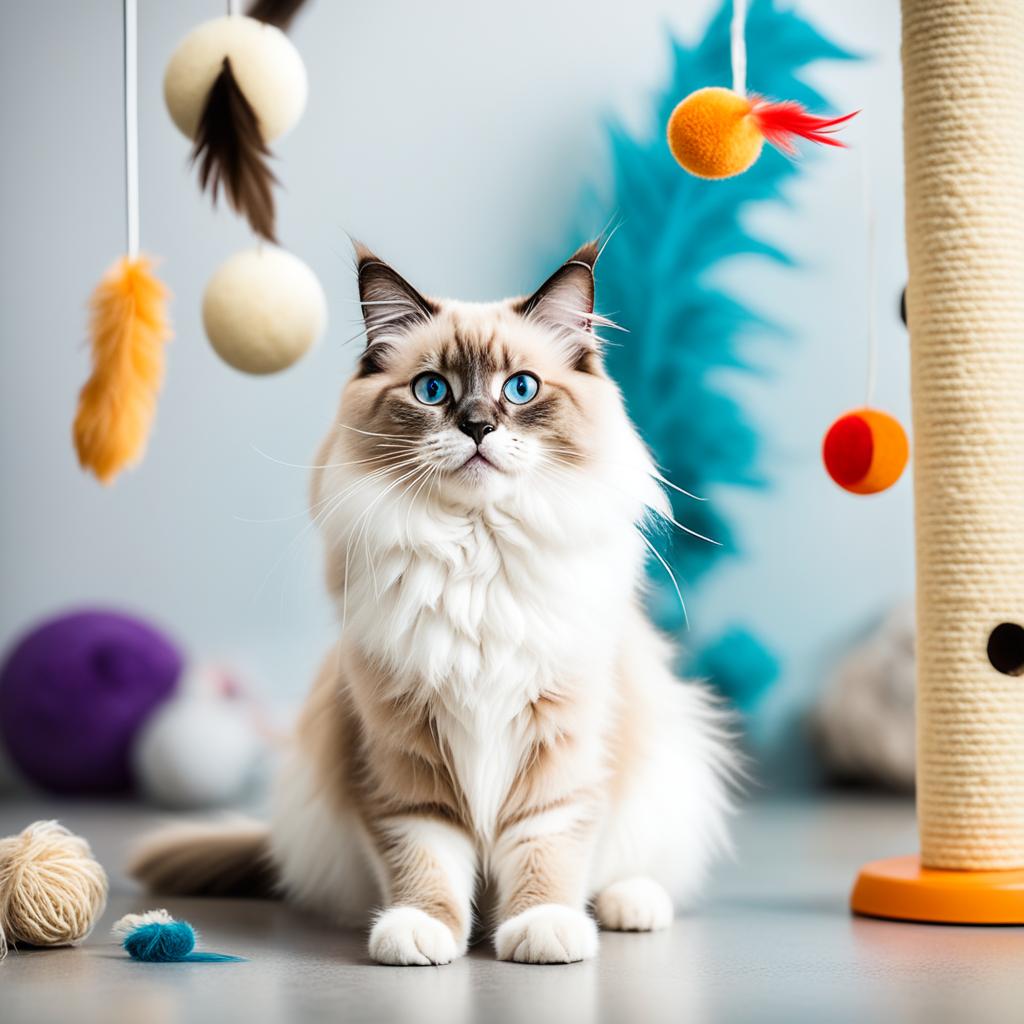
Is your Ragdoll cat always chasing its tail? It’s time to act. Start by creating ample stimulation. Things like interactive toys and puzzle feeders keep them busy. This lowers the chance of tail chasing due to boredom.
Next, make sure the cat lives in a stable environment. Stress can lead to obsessive behavior like tail chasing. A peaceful home with safe spots is key.
If the above steps don’t help, consider a feline behavior expert. They provide great advice to stop tail chasing. Their help ensures your cat is both mentally and physically well.
Here’s a brief list of what to do:
- Give interactive toys and puzzle feeders
- Make a safe, comforting home
- Get expert advice if needed
By following these tips, your Ragdoll cat can kick the tail-chasing habit. This way, they live a better, stress-free life.
Managing Ragdoll Cat Tail Chasing Habits
To tackle your Ragdoll cat’s interest in chasing its tail, a broad strategy is key. This includes keeping them physically active, staying on top of their health with vet check-ups, and creating an interesting but safe space. These steps can help cut down or stop the habit altogether.
Providing Adequate Stimulation
Ragdoll cats love interactive play and fun activities. To curb tail chasing, add toys that stimulate and puzzle feeders into their daily regime. These can take their mind off their tail and keep them busy in a positive way.
Ensuring Proper Health Check-ups
Regular vet check-ups are a must. Various health issues can lead to tail chasing, like allergies or infections. By keeping up with health visits, you catch and fix problems early. This makes sure your cat is healthy and happy, and less likely to chase its tail.
Creating a Safe and Engaging Environment
The environment your Ragdoll cat lives in influences its behavior a lot. Make their space exciting but safe, with places to climb and hide. A stress-free environment with plenty of fun activities helps keep their mind off their tail.
So, keep their space calm and filled with interactive fun. This way, your Ragdoll cat will stay busy and not focus on chasing its tail.




